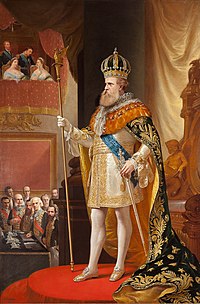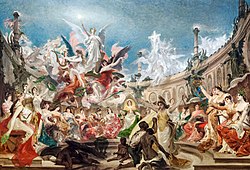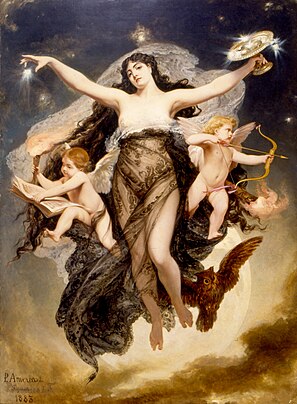Pedro Américo
Pedro Américo de Figueiredo e Melo (29 April 1843 – 7 October 1905) was a Brazilian novelist, poet, scientist, art theorist, essayist, philosopher, politician and professor, but is best remembered as one of the most important academic painters in Brazil, leaving works of national impact.
Américo graduated in Social Sciences at the Sorbonne, delving into architecture, theology, literature and philosophy, and attended classes by Victor Cousin, Claude Bernard and Michael Faraday at the Collège de France and the Conservatory of Arts and Crafts.
The approval was reported in several Brazilian and Belgian newspapers in extremely laudatory terms, assuming the character of a scientific event, and according to his first biographer, he was awarded the Order of the Holy Sepulcher, granted by Pope Pius IX.
However, taking advantage of the wave of patriotism unleashed by the Brazilian victory in the Paraguayan War, and encouraged by the emperor, he painted the canvas Batalha do Campo Grande, a large-scale composition in which he sought to praise the monarchy and the main hero in the battle, the Count of Eu.
[4][7][9][12] In this period and in the same spirit Américo also produced Fala do Trono, Ataque à Ilha do Carvoeiro, Passo da Pátria, Passagem do Chaco, and began the sketches for the government's of what was one of his greatest masterpieces, the large Batalha de Avaí, which was painted in Florence beginning in 1874 and being finished only in 1877.
[15] Américo spent the following years mainly in Florence, abandoning civic matters that had a market only in the government itself and dedicating himself to works of a late and sentimental Romanticism, in allegories and scenes of oriental, historical or biblical themes, types that he personally preferred and that had greater penetration among the public, among them A Noite acompanhada dos gênios do Estudo e do Amor, Joana d'Arc ouve pela primeira vez a voz que lhe prediz o seu alto destino, A rabequista árabe, Os filhos de Eduardo IV and Dona Catarina de Ataíde e Jocabed levando Moisés até o Nilo.
[4][7][10] In 1885 Américo briefly visited France and returned to Brazil to take up the chair of art history, aesthetics and archeology at the Imperial Academy, to which the emperor was assiduously present, and in the following year he published another novel, Amor de Esposo.
Américo produced more important works for the new regime: Tiradentes esquartejado (part of a projected series on the Minas Gerais Conspiracy that he did not perform), Libertação dos escravos and Honra e Pátria e Paz e Concórdia.
[17][18][19][20] To achieve this goal, emperor Pedro II, a lover of the arts and sciences who in 1856 had written that the two great works he needed to accomplish were "to morally organize the nationality and form an elite",[6] promoted a nationalist program of internal modernization and dissemination of Brazil abroad.
Activities focused on the Imperial Academy of Fine Arts, founded in 1816 and for many years in precarious operation, but since the 1850s it had been restructured and energized by a more consistent and enlightened state sponsorship and by the work of scholars such as Manuel de Araújo Porto-Alegre.
[29][30] But Brazilian Romanticism in painting, where Pedro Américo is included, was that of the third romantic generation, when the movement had already lost its original, passionate and revolutionary character, transforming itself into a softer and more conformist, more aesthetic and sentimental current, which quickly became bourgeois and in many ways genuinely "popular".
[17][22][31][32] Among the artists who were possibly an influence on Américo's most important works are Horace Vernet, Antoine-Jean Gros, Eugène Delacroix, Théodore Géricault and François Gérard, as well as the Italian painters of the Risorgimento, such as Luigi Bechi.
To achieve its goals, history painting could work with religious themes, properly historical, or absorb mythical figures from the classical past to allegorically lend greater brightness to current events, or to evoke exemplary virtues.
From the Baroque onwards, the historical genre entered its golden phase, when the potential of its visual rhetoric was perceived and explored in depth by elites and governments, and, indifferent to the change in styles over the successive centuries, continued to serve the same purposes, always more linked to the civil sphere of society, although it could often incorporate religious elements in a period when Religion and the State lived in close proximity and the doctrine of the divine right of kings was articulated.
[5][12][17][19][21][34] The genre did not take root in Baroque Brazil because there was no court that sponsored it or academies that taught it; the territory was a Portuguese colony and its painting, almost entirely based on religious worship, was made in a corporative and semi-artisanal system.
[36][37] However, as its tropical version took a long time to work and Brazil, an independent Empire since 1822, was in perennial upheaval and could not present anything too grandiose to be proud of in the face of a disaffected population still indifferent to the academic arts, the genre did not immediately prosper.
In addition to being a personal preference, they were a reflection of a change in context and catered to the taste of a new, bourgeois and sentimental audience, which was not a market for traditional historical works, but began to appreciate images that were more related to their own reality or were consumables without further complications.
[4][12][46][47] In part, this shift in general preferences towards the prosaic and accessible were due to the rise of realistic aesthetics, progressively incorporated by academics at the end of the 19th century, and the popularization of photography, which painters such as Pedro Américo began to make use of as a painting aid.
[6][49] His first literary essays were poems written while he was studying at the Pedro II College,[6] and his most relevant text is Science and Systems: Questions of Natural History and Philosophy,[50] a thesis he defended at the Free University of Brussels.
[49] Carolina Invernizio's analysis highlighted Américo's opposition to positivism, a very influential philosophy in France and Brazil at the time,[6] and his more direct affiliation, according to Sílvio Romero and José de Carvalho, was the spiritualist strand of French eclecticism, approaching the thinking of Victor Cousin, Jules Michelet and Edgar Quinet.
[51] In the thesis preface, Américo warned that:[52] "If this book had been written in Brazil, it would certainly lack local color, since none of the issues that I address with some developments are treated here from a national point of view; therefore, anyone who reads it without thinking about this fact – that the moral and intellectual situation of Europe differs greatly from ours – would find it, in many ways, empty and meaningless.
[6] His participation in the politics of the new republic as a deputy yielded several speeches and projects, collected and published as Discursos Parlamentares (1892), where, often, disillusioned, he criticized the inertia and immaturity of public power, denounced the similarity between monarchical rhetoric and the republican one and deplored the general backwardness in which Brazil lived.
They are semi-autobiographical, manichean, argumentative, asymmetrical, proselytizing, in which typically young men from poor families, but with integrity, heroically try to climb the steps of improvement by their own effort, in the midst of infinite torments and the opposition of the forces of evil, represented by the incomprehension, envy, lack of perspective and the apathy of others.
In Na Cidade Eterna, the desolate lament of Heitor de Montalvano, its tragic hero, a solitary man "with a torn soul", but pure and upright, who struggled ingloriously against politics, "the monster without entrails", essentially repeats the same theme:[6] "For those who know the mirages produced by the imagination of a thirsty soul, and has already tasted the sadness generated by the disappointments of existence, only the inner world is worthy of sheltering them, as well as containing the ideals that still surround them as a last caress; only the mastery of these impalpable realities born in the depths of feeling and illuminated by the beam of poetry have the charms that can ease the pains of a life not comforted by hopes."
It is not surprising that a man who, in addition to considering himself the greatest painter of his the time, boasted of having refuted Bacon, Kant and Comte in the field of philosophy and even risked as a novelist, attributed to his own works a high historical value".
[6][12][55] At only fifteen years old, already aware of his talent, he had requested the personal sponsorship of the emperor,[54] and throughout his career he sought his promotion systematically, obtaining an unprecedented international response for a Brazilian, being the subject of about 300 articles published in many countries of the world.
In a speech he gave in 1870 in the presence of the emperor, on the occasion of the inauguration of the Aesthetics and Art History course at the Imperial Academy, Pedro Américo described the artists as "true prophets of civilization" engaged "in the battles of progress".
Duque also attacked Américo's philosophical writings and novels, saying that the artist embarked on areas that did not concern him, only out of vanity, and whose fruits were anachronisms that only satisfied frivolous spirits: "It was not enough for him to conquer the secrets of his art, he wished moreover, he sought the honors of a parchment, graduated from the Sorbonne and then obtained a doctorate in Belgium.
The difficulty grows in proportion to the artist's needs – a kind of historian bound by the demands of aesthetics and the uncertainties of tradition – to identify circumstances whose veracity can be doubted, and which not even because they are real deserve the attention of history and the consecration of the beautiful".
Probably his scientific training also inclined him to this – although he himself rejected the label of a realist painter – and by adopting this anti-academic, anti-idealist procedure, he received a partial approval by the critics of the academy, who considered him a renovator of the historical genre in comparison to the more "old-fashioned" and "conservative" Victor Meirelles.

















